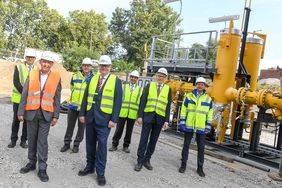
STEAG power plant project reaches next milestone
Herne/Dortmund/Essen. Construction of STEAG’s new combined cycle power plant in Herne is making good progress. Following connection of the plant to the Thyssengas natural gas network almost a year ago, representatives of Thyssengas, STEAG and plant manufacturer Siemens Energy have now symbolically opened the valve for supply of natural gas to the modern and highly efficient power plant.
The new, ultra-modern and resource-saving plant operates on the principle of cogeneration. This means that with an installed electrical capacity of around 600 megawatts (MW), it generates electricity and, with 400 MW of thermal output, heat at the same time.
“This means that the new Herne combined cycle power plant ideally meets the requirements of a forward-looking energy supply: it guarantees security of supply, is economical and efficient, and thus environmentally compatible,” says Joachim Rumstadt, Chairman of the Board of Management of STEAG GmbH.
Securing the district heating supply
With this high level of efficiency, the new power plant, which is scheduled to come on stream in the summer of 2022, will make an important contribution to securing the long-term supply of district heating in the Ruhr region. The system’s emissions balance will once again be significantly improved with the new combined cycle power plant: compared with the hard coal fired power plant previously operated at the Herne site, the Herne CCGT will in future reduce CO2 emissions by 50 percent per year.
“This significant improvement in the environmental balance sheet is made possible thanks to a particularly high overall utilization rate of 85 percent for the natural gas used in the combined cycle plant. This is a peak value that is unparalleled in the world,” says Dr. Ralf Schiele, the Director of STEAG GmbH responsible for Market and Technology.
Thyssengas plans and builds pipeline in record time
Connection to the natural gas transmission grid is an essential condition for commissioning of STEAG’s new combined cycle power plant in Herne. The contract for that work was awarded to the long-distance pipeline operator Thyssengas GmbH from Dortmund. After several years of planning and the granting of planning approval in November 2019, Thyssengas succeeded in laying the 23-kilometer pipeline within just two years – in spite of the challenges in the route, such as a crossing below the Emscher River and the Rhine-Herne Canal, and the ongoing Corona pandemic. The new gas pipeline runs from the connection point in Datteln to the power plant site in Herne, crossing urban districts in Oer-Erkenschwick, Recklinghausen and Herten along the way. The project was one of the largest new construction projects for Thyssengas in recent years.
Contribution to a successful energy transition
At the joint press conference of the companies involved, Dr. Thomas Gössmann, Chairman of the Executive Board of Thyssengas, made clear the importance of the joint project in the gradual decarbonization of the energy supply: “With the construction of the new Datteln-Herne line, we have not only fulfilled our legal mandate to ensure the connection to the power plant, but are also helping to shape the energy transition in the Ruhr region. After all, in the medium term natural gas will play a key role as a bridging technology, ensuring that Germany’s energy supply remains reliable and flexible.”
Favorable interim assessment of the project
Plant manufacturer Siemens Energy also takes a favorable view of the current project status. “We are very pleased that, despite challenging general conditions, we have succeeded in keeping the project essentially on schedule in a joint effort by all those involved, even with the additional challenge of the Corona pandemic,” says Tim Dawidowsky, Senior Vice President Project Excellence at Siemens Energy.
He also remarks that the new-build power plant is an important milestone for Siemens Energy on its chosen course toward decarbonization. “Our goal is to support our customers with the latest and most efficient technologies and systems in the energy industry, no matter how far they have come in the energy transition,” Tim Dawidowsky emphasizes. Today, gas turbines from Siemens Energy are already capable of co-firing a certain amount of admixed hydrogen, which opens up further opportunities for reducing emissions as soon as the hydrogen economy takes off, he adds.
Milestone in industrial policy for the Ruhr metropolis
The Mayor of Herne, Dr. Frank Dudda, sees the construction of the new power plant as an important signal for the Ruhr industrial region: “The combined cycle power plant, which is now nearing completion, shows that here at the Ruhr we want infrastructure projects of this kind and can carry them through – quite apart from the fact that it also brings us much closer to our goal of becoming Germany’s greenest industrial region,” says the Mayor, who is also Chairman of the Regional Association of the Ruhr (RVR), assessing the significance of the project for the metropolitan region.
